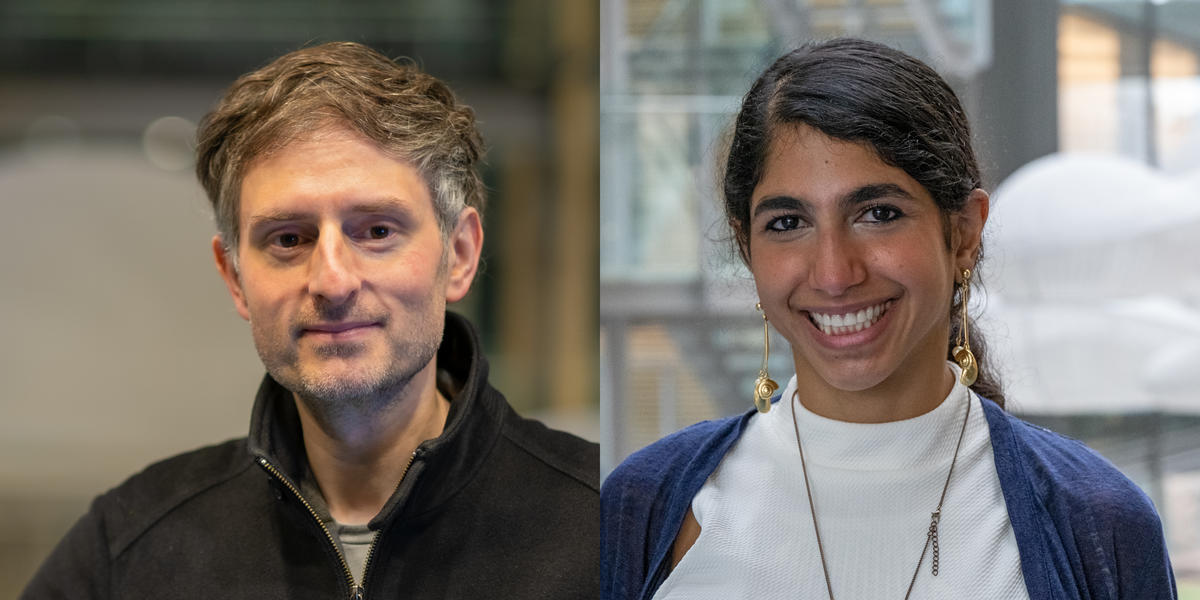Great chemistry from the “Mo” Lab Meets Industrious Postdoc
A luncheon two years ago at the University of Illinois at Chicago hosted by graduate students – a pre-pandemic tradition that seems almost quaint by today’s COVID constraints – gave Maryam Elfeki the chance to talk with Mohammad Seyedsayamdost about his signature technology.
Elfeki had already read up on High Throughput Elicitor Screening (HiTES) in a few journals. She was intrigued with its potential. She knew, because she checked, that patents had been secured in its name to protect the intellectual property.

Photo by C. Todd Reichart
Developed as a drug discovery platform by Seyedsayamdost, an associate professor in the Department of Chemistry, HiTES provides a means to activate “silent” natural product biosynthetic genes in bacteria, which can aid in the development of new medicines. Some 70% of our antibiotics are derived from bacterial natural products, and an untold number of molecules await discovery. HiTES provides an elegant way to find them.
Elfeki was still a graduate student at UIC when she asked Seyedsayamdost if he intended to transfer his technology from lab to company. And then she asked for a job.
“He was so approachable. He was funny and interesting and so passionate about his science,” said Elfeki, today a postdoctoral fellow in the Seyedsayamdost Lab. “I just asked if he was interested in commercializing it. It’s always been my dream to start a drug discovery company.”
Cryptyx Bioscience was born from that encounter. Now on the cusp of a broader application with HiTES at its core, Cryptyx is matching its technology to the needs of the drug discovery industry.
“The skills required to run a startup are not taught in typical academic training. For that reason, assembling a team that covers all the necessary skill sets is an important first step,” said Seyedsayamdost, who was awarded a MacArthur Fellowship last fall for his research on the biosynthesis of these novel molecules.
“What Maryam brings to the HiTES team is energy, business acumen, and an entrepreneurial spirit. I had been playing with the idea of commercializing our technology, and my immediate impression after meeting and talking with her was that she was the right partner for this job.”
Considering all the labs there are on Princeton’s campus, let alone throughout the country, an enormous amount of research is generated yearly with vast potential for solutions to real-world problems. But because of a multitude of factors – time constraints, cost, incapacity to scale technology – scientists struggle to bring their work to application, and much research languishes in the lab.

Photos by C. Todd Reichart
Increasingly, a generation of younger researchers raised on the entrepreneurial mindset have stepped in to stoke the momentum and focus on development. Elfeki is one of them, honing her business skills working with Princeton’s Office of Technology Licensing and at a similar office at UIC two years ago. She also completed the Princeton Startup Bootcamp in January.
“It’s more and more common that grad students and postdocs are looking to be entrepreneurial. You’ve heard of the gene editing tool CRISPR?” Elfeki asked, referring to the revelation of the CRISPR/Cas9 “genetic scissors” that earned its two lead scientists the 2020 Nobel Prize in Chemistry. “But there are a lot of smaller and potentially disruptive discoveries that don’t get that much news coverage.”
PROVOKING BACTERIA
In recent years, scientists have explored how bacteria communicate or compete with each other, plumbing these adaptive responses to develop a raft of new drugs. But the process is outdated, slow, and expensive. And until recently, the prevailing attitude was that scientists had wrung all the possibilities out of standard lab methods.
Cryptyx takes that process to a whole new level.
HiTES deploys “elicitors” in the form of compounds that goad otherwise silent or unresponsive biosynthetic genes into producing never-before-seen molecules. These, in turn, could form the basis of new therapies.
“If you’re growing these bacteria in a monoculture, there’s no competition. A few well-studied bacteria produce only about 30% of what they’re capable of,” said Elfeki. “When we use HiTES, where we add a few elicitors, these same bacteria produce 80% and 90% of what they’re capable of. From this method, we’ve already found dozens of novel compounds.”
Through HiTES, the Seyedsayamdost lab has identified more than 50 cryptic natural products – molecules not produced under standard growth conditions – with diverse biological activities. In turn, those discoveries have provided superior drug leads against such diseases as C. Diff, drug-resistant Mycobacterium tuberculosis, and respiratory syncytial virus (RSV), among others.
The lab is also expanding its molecular library to provide the drug discovery pipeline with leads on new therapies.
“A lot of people have tried to activate those silent genes by using more complex methods. But with HiTES,” said Elfeki, “it’s just so simple and elegant.”
